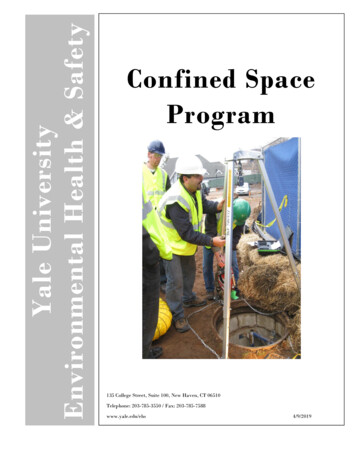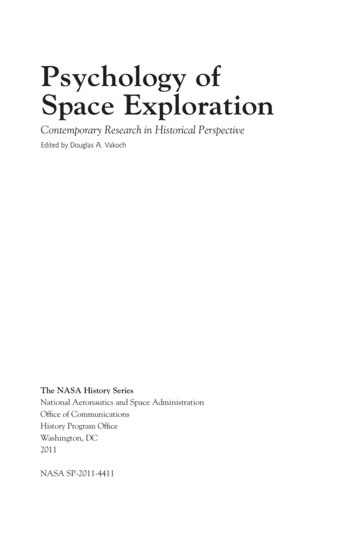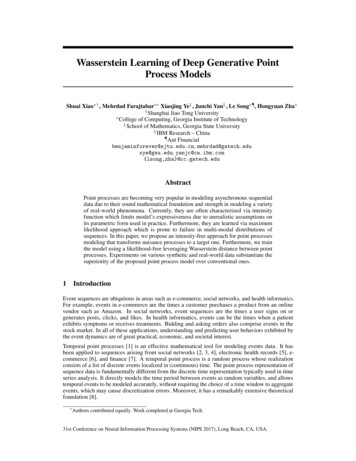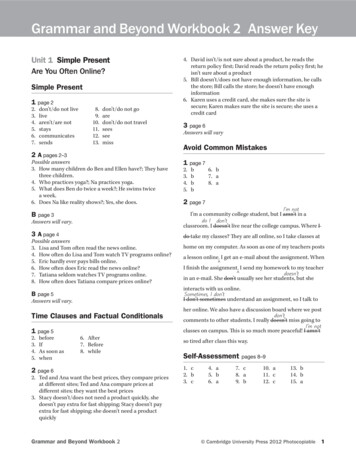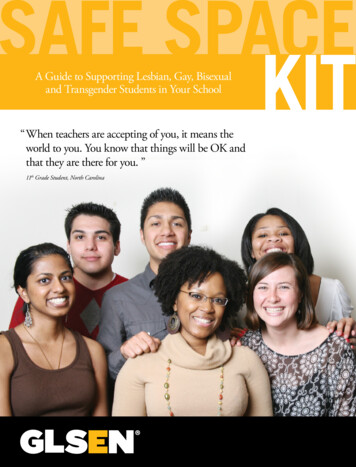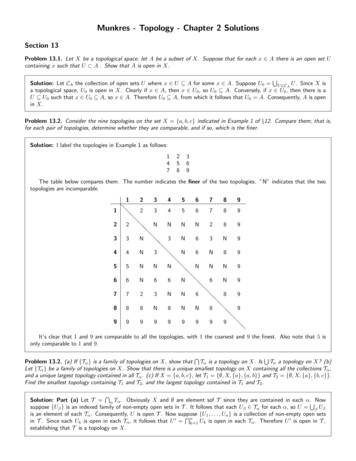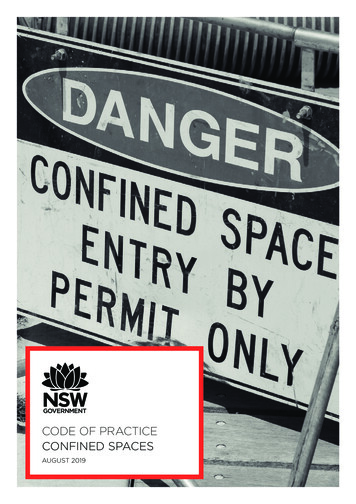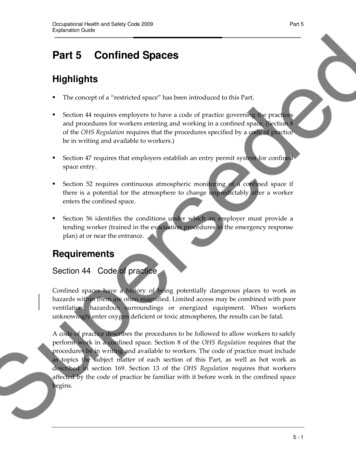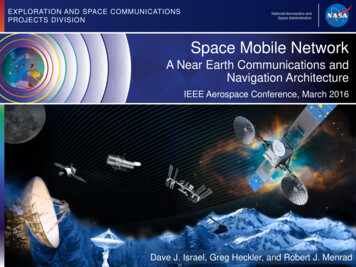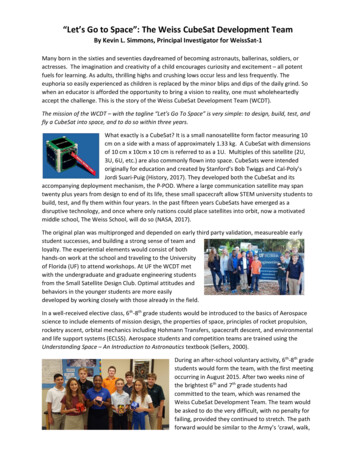
Transcription
“Let’s Go to Space”: The Weiss CubeSat Development TeamBy Kevin L. Simmons, Principal Investigator for WeissSat-1Many born in the sixties and seventies daydreamed of becoming astronauts, ballerinas, soldiers, oractresses. The imagination and creativity of a child encourages curiosity and excitement – all potentfuels for learning. As adults, thrilling highs and crushing lows occur less and less frequently. Theeuphoria so easily experienced as children is replaced by the minor blips and dips of the daily grind. Sowhen an educator is afforded the opportunity to bring a vision to reality, one must wholeheartedlyaccept the challenge. This is the story of the Weiss CubeSat Development Team (WCDT).The mission of the WCDT – with the tagline “Let’s Go To Space” is very simple: to design, build, test, andfly a CubeSat into space, and to do so within three years.What exactly is a CubeSat? It is a small nanosatellite form factor measuring 10cm on a side with a mass of approximately 1.33 kg. A CubeSat with dimensionsof 10 cm x 10cm x 10 cm is referred to as a 1U. Multiples of this satellite (2U,3U, 6U, etc.) are also commonly flown into space. CubeSats were intendedoriginally for education and created by Stanford’s Bob Twiggs and Cal-Poly’sJordi Suari-Puig (History, 2017). They developed both the CubeSat and itsaccompanying deployment mechanism, the P-POD. Where a large communication satellite may spantwenty plus years from design to end of its life, these small spacecraft allow STEM university students tobuild, test, and fly them within four years. In the past fifteen years CubeSats have emerged as adisruptive technology, and once where only nations could place satellites into orbit, now a motivatedmiddle school, The Weiss School, will do so (NASA, 2017).The original plan was multipronged and depended on early third party validation, measureable earlystudent successes, and building a strong sense of team andloyalty. The experiential elements would consist of bothhands-on work at the school and traveling to the Universityof Florida (UF) to attend workshops. At UF the WCDT metwith the undergraduate and graduate engineering studentsfrom the Small Satellite Design Club. Optimal attitudes andbehaviors in the younger students are more easilydeveloped by working closely with those already in the field.In a well-received elective class, 6th-8th grade students would be introduced to the basics of Aerospacescience to include elements of mission design, the properties of space, principles of rocket propulsion,rocketry ascent, orbital mechanics including Hohmann Transfers, spacecraft descent, and environmentaland life support systems (ECLSS). Aerospace students and competition teams are trained using theUnderstanding Space – An Introduction to Astronautics textbook (Sellers, 2000).During an after-school voluntary activity, 6th-8th gradestudents would form the team, with the first meetingoccurring in August 2015. After two weeks nine ofthe brightest 6th and 7th grade students hadcommitted to the team, which was renamed theWeiss CubeSat Development Team. The team wouldbe asked to do the very difficult, with no penalty forfailing, provided they continued to stretch. The pathforward would be similar to the Army’s ‘crawl, walk,
run’ model: first the basics and bench work, then progressively more realistic anddifficult tasks with captive carry flights, tethered and high altitude balloons, andfinally orbital spacecraft development.Students began by working with the BLUECUBE Aerospace (BCA) 1U CubeSatemulator describe. BCA is a small company formed by Albert Einstein DistinguishedEducator Fellows with the intention of helping students learn through using aunique CubeSat emulator. Students 3D printed 1U chasses, and assemble theRaspberry Pi-based BCA emulators. Student-created Python-based code allowsremote access to emulator data, consisting of multiple sensor data and cameraimages via a Wi-Fi network to student laptop graphic user interface (Simmons,2015).Early third party validation and a nod of successcame from the interaction with Generation Orbit(GO), an Atlanta-based, NewSpace company (Olds,2017). GO personnel conducted a weekendworkshop at the school and later WCDT studentstraveled to Cartersville, Georgia where they completed their first finalflight review (FFR) prior to an emulator captive-carry flight. Inside anelectronics jammer pod under the wing of a modified Leer jet, a WCDT emulator collected sensor datawhile the jet flew numerous high ‘g’ flight profiles.Then students turned their attention towards conducting their first tethered balloon and CubeSatemulator flights in the spring of 2016. Numerous tethered ‘balloonsat’ missions occurred over the nextmonths as the students gained knowledge in several areas. A memorable photograph taken from anairborne emulator shows several of the Weiss students forming the Weiss ‘W’.During summer 2016 theauthor traveled to theSmallSat conference at UtahState University. It is theworld’s largest meeting forthe CubeSat community(SmallSat, 2017). The purpose of attending was toprepare for the upcoming NASA CubeSat LaunchInitiative application period. The author also metwith key NASA personnel and companies whichwould later become the WCDT primary spacecraft bus and payload contractors.Applying for the CSLI would also provide external validation for not only the program but buildconfidence in the students. Having a due date in November, it was mid-February 2017 that NASAannounced their selections for the third round ofthe CSLI (Berzinski, 2016). The satellite to be builtby the WCDT would be called the WeissSat-1, withthe understanding that this would be the first ofmany spacecraft. This educational CubeSat isprimarily intended to train students, its secondarypurpose is to collect data as to the viability ofextremophile bacteria in melting ice while in LEO(NYRAD, 2017). With great anticipation NASA
announced selections for the 8th round of the CSLI in February 2017 (Jackson,2016). Of 34 proposals selected, 31 were from universities, but only one middleschool. The WCDT was further honored by a visit from one-time shuttle astronautand current Senator Bill Nelson, who held a press briefing at The Weiss School inMarch (WPTV, 2017). Selection by NASA not only provided additional validation butalso greatly enhanced team espirit de corps. Many new students joined.In April 2017 the WCDT demonstrated growth in itscapabilities by successfully launching it first high altitudeballoonsat (HAB) mission. With support from theWeissSat-1’s primary bus partner, NearSpace Launch Inc.(NSL), students gained valuable experience with atransmitter similar to the flight hardware and in using thedata downlink provided by the GlobalStar network of satellites. Launched fromthe school, live video transmission and over 250 data points were collected during the 4 hour mission,which ended in the Atlantic north of the Bahama Islands.Last summer eleven WCDT students attended the 31st annualSmallSat Workshop and Conference in Logan, Utah. This was thefirst year a middle school student team attended. It was incrediblybeneficial to the team in that they spent a week with like-mindedprofessionals and university students, and they were well received.Utah Public Radio interviewed members of the team which aired onAugust 29, 2017 (Teichert, 2017).At The Weiss School spinoff benefits of the WCDT are numerous. Through the school’s DistinguishedSpeaker Series, astronauts Story Musgrave and Apollo 16 moonwalker Charlie Duke have visited andpresented (Berzinski, 2016; Peters, 2017). Students are frequently invited to exhibit and present atAerospace conferences and banquets, including the American Institute of Aeronautics and Astronautics,the Missileers and Space Range Pioneers, and the Humans2MarsSummit. (Humans, 2017). Weiss annually conducts highlysuccessful aerospace summer camps, and leads a NASAsponsored Space Settlement Contest working with students fromseveral nations to form a single team. WCDT members call onCongress with the Space Exploration Alliance (Space, 2017;Congressional, 2017).Weiss has sharply increased participation in regional and state-level science and engineering fairs, andhigh school only competitions. In the recent Regional Science/Engineering Fair Weiss won best overallproject, won five of eleven categories entered, and 18 of 23 students placed. Many of these projectswere Aerospace-themed.This author believes the ultimate teachingfrontier is at the intersection of aerospace,biotechnology, and entrepreneurship. Havingan opportunity to unleash a ‘blue-sky’ visionthat encompasses all three in the form of asatellite carrying a biotechnology payloadrepresents the ultimate real-world studentchallenge. During the WeissSat-1 missionstudents at times will fail, and learn from it.
Students will gain academic confidence through this experience. Getting to space requires them to‘work hard, work smart.’At the time of this writing the WCDT had recently met again with its payload partner, NYRAD, and willsoon receive its full WeissSat-1 engineering unit from NSL. Once received, students will test hardware toprepare for NASA’s stringent certification testing. NASA personnel have indicated that WeissSat-1 willmost likely be manifested soon for a 2018-Q4 launch. Candidly the team hopes for a Florida launch, butwill gladly accept any ride NASA provides. In the meantime they prepare for another HAB mission withthe goal of reaching at least 30,500m ( 100,000 ft). Why do something so risky and so difficult? Whynot? Let’s Go To Space.REFERENCESBerzinski, S. (2016, October 07). Former astronaut, Story Musgrave, speaks to students. RetrievedNovember 23, 2017, from -musgrave-speaks-tostudents/3370426Berzinski, S. (2016, October 07). Students embark on college-level aerospace project. RetrievedNovember 23, 2017, from lege-level-aerospaceproject/3388267Congressional Visits Day Program. (n.d.). Retrieved November 23, 2017, from https://www.aiaa.org/cvd/History of the CubeSat. (n.d.). Retrieved November 23, 2017, fromhttp://www.spacedaily.com/reports/History of the CubeSat 999.htmlHumans to Mars 2017 by National Institute of Aerospace. (n.d.). Retrieved November 23, 2017, 7Jackson, S. (2017, February 17). NASA's CubeSat Launch Initiative. Retrieved November 23, 2017, eSats initiativeJackson, S. (2017, February 17). NASA Announces Eighth Class of Candidates for Launch of CubeSatSpace. Retrieved November 23, 2017, from ssionsPeters, Sarah. Palm Beach Post Staff Writer 11:04 a.m. Thursday, April 20, 2017 Northern Palm BeachCounty. (n.d.). Astronaut tells students a record high jump on moon almost killed him. RetrievedNovember 23, 2017, from him/rb0bQMcSVWLAE3ZB6MH7vM/Olds, John. Generation Orbit. (n.d.). Retrieved November 23, 2017, from http://generationorbit.com/NASA. Small Spacecraft Technology State of the Art. (2015) /files/small spacecraft technology state of the art 2015 tagged.pdfNearSpace Launch Inc. (n.d.). Retrieved November 23, 2017, from https://nearspacelaunch.com/NYRAD, I. (n.d.). Space Systems, Engineering Space, Aerospace Engineering. Retrieved November 23,2017, from https://nyradspace.com/Sellers, J. J. (n.d.). Understanding Space: An Introduction to Astronautics (2004, 2nd ed., SpaceTechnology Series).
Simmons, K. (n.d.). BLUECUBE Aerospace. Retrieved November 23, 2017, fromhttp://www.bluecubesat.com/SmallSat Conference 2017. (n.d.). Retrieved November 23, 2017, from https://www.smallsat.org/Space Exploration Alliance. (n.d.). Retrieved November 23, 2017, rt, B. (n.d.). Students Launching Future Careers Building Small Satellites. Retrieved November 23,2017, from ers-building-small-satellitesWPTV. (2017, March 14). Students at The Weiss School learn their satellite will go to space. RetrievedNovember 23, 2017, from https://www.youtube.com/watch?v 6qpaa5TgE1M
A CubeSat with dimensions of 10 cm x 10cm x 10 cm is referred to as a 1U. Multiples of this satellite (2U, 3U, 6U, etc.) are also commonly flown into space. CubeSats were intended originally for education and created by Stanfords Bob Twiggs and Cal-Polys Jordi Suari-Puig (History, 2017). They developed both the CubeSat and its
